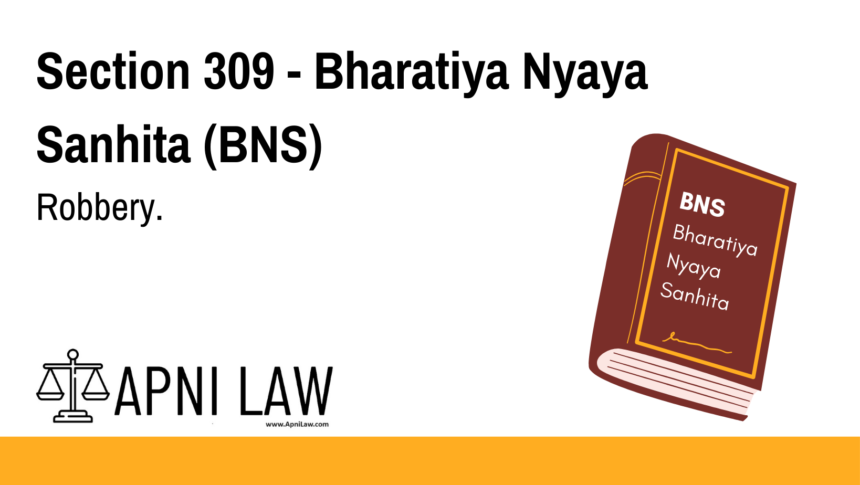Code: Section 309 BNS
(1) In all robbery there is either theft or extortion.
(2) Theft is robbery if, in order to the committing of the theft, or in committing the theft,
or in carrying away or attempting to carry away property obtained by the theft, the offender,
for that end voluntarily causes or attempts to cause to any person death or hurt or wrongful
restraint, or fear of instant death or of instant hurt, or of instant wrongful restraint.
(3) Extortion is robbery if the offender, at the time of committing the extortion, is in the
presence of the person put in fear, and commits the extortion by putting that person in fear of
instant death, of instant hurt, or of instant wrongful restraint to that person or to some other
person, and, by so putting in fear, induces the person so put in fear then and there to deliver
up the thing extorted.
Explanation.—The offender is said to be present if he is sufficiently near to put the
other person in fear of instant death, of instant hurt, or of instant wrongful restraint.
Illustrations.
(a) A holds Z down, and fraudulently takes Z’s money and jewels from Z’s clothes,
without Z’s consent. Here A has committed theft, and, in order to the committing of that theft,
has voluntarily caused wrongful restraint to Z. A has therefore committed robbery.
(b) A meets Z on the high road, shows a pistol, and demands Z’s purse. Z, in
consequence, surrenders his purse. Here A has extorted the purse from Z by putting him in
fear of instant hurt, and being at the time of committing the extortion in his presence. A has
therefore committed robbery.
(c) A meets Z and Z’s child on the high road. A takes the child, and threatens to fling it
down a precipice, unless Z delivers his purse. Z, in consequence, delivers his purse. Here A
has extorted the purse from Z, by causing Z to be in fear of instant hurt to the child who is
there present. A has therefore committed robbery on Z.
(d) A obtains property from Z by saying—“Your child is in the hands of my gang, and
will be put to death unless you send us ten thousand rupees”. This is extortion, and punishable
as such; but it is not robbery, unless Z is put in fear of the instant death of his child.
(4) Whoever commits robbery shall be punished with rigorous imprisonment for a term
which may extend to ten years, and shall also be liable to fine; and, if the robbery be committed
on the highway between sunset and sunrise, the imprisonment may be extended to fourteen
years.
(5) Whoever attempts to commit robbery shall be punished with rigorous imprisonment
for a term which may extend to seven years, and shall also be liable to fine.
(6) If any person, in committing or in attempting to commit robbery, voluntarily causes
hurt, such person, and any other person jointly concerned in committing or attempting to
commit such robbery, shall be punished with imprisonment for life, or with rigorous
imprisonment for a term which may extend to ten years, and shall also be liable to fine.
Explanation of Section 309 BNS
Section 309 BNS defines robbery as a combination of theft and extortion, where the offender uses force, threats, or fear to acquire property unlawfully. It clearly differentiates between theft with force (robbery) and extortion without immediate threat to life or limb.
The section also specifies punishments based on the severity of the crime, with harsher penalties for robbery on highways and cases where hurt is caused during the crime.
Illustrations
Example 1: Robbery with Threats
A meets B on a deserted road, pulls out a knife, and demands B’s wallet. B, fearing for his life, gives the wallet. This qualifies as robbery under Section 309 BNS.
Example 2: Robbery Involving Physical Force
C forcibly snatches a bag from D’s hand while pushing D violently, causing D to fall. This is robbery since C used force to commit theft.
Example 3: Extortion Without Immediate Threat
E threatens F over the phone, claiming F’s child will be harmed unless a ransom is paid. If F doesn’t see the child, this may be extortion but not robbery unless there’s an immediate threat.
Common Questions and Answers on Section 309 BNS
1. What is the difference between theft and robbery?
- Answer: Theft involves taking property without consent, while robbery involves theft with force, threats, or fear of immediate harm.
2. Is extortion considered robbery?
- Answer: Yes, if the offender is present and puts the victim in fear of instant harm during the extortion, it qualifies as robbery.
3. What are the penalties for robbery?
- Answer: Robbery can lead to up to 10 years of rigorous imprisonment, a fine, or even 14 years if committed on the highway between sunset and sunrise.
4. Can robbery be committed without using a weapon?
- Answer: Yes, if the offender uses threats, intimidation, or fear to force someone to hand over property, it still qualifies as robbery.
5. What if no physical harm is caused during robbery?
- Answer: Even if no physical harm is caused, the use of threats, fear, or force can still make the act a robbery under Section 309 BNS.
Conclusion
Section 309 BNS provides a comprehensive definition of robbery, encompassing both theft and extortion when accompanied by force, threats, or fear. The section also outlines severe punishments to deter such crimes, especially when they involve violence or occur on highways during night hours.
For expert legal insights, visit ApniLaw today! 🚀











